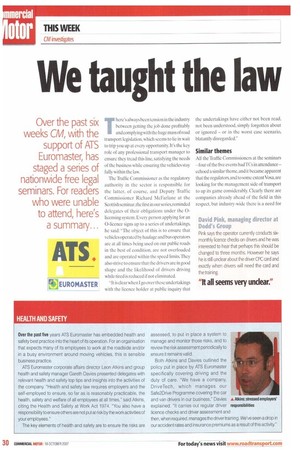HEALTH AND SAFETY
Page 30

If you've noticed an error in this article please click here to report it so we can fix it.
Over the past five years ATS Euromaster has embedded health and safety best practice into the heart of its operation. For an organisation that expects many of its employees to work at the roadside and/or in a busy environment around moving vehicles, this is sensible business practice.
ATS Euromaster corporate affairs director Leon Atkins and group health and safety manager Gareth Davies presented delegates with relevant health and safety top tips and insights into the activities of the company. "Health and safety law requires employers and the self-employed to ensure, so far as is reasonably practicable, the health, safety and welfare of all employees at all times," said Atkins, citing the Health and Safety at Work Act 1974. "You also have a responsibility to ensure others are not put at risk by the work activities of your employees."
The key elements of health and safety are to ensure the risks are assessed, to put in place a system to manage and monitor those risks, and to review the risk assessment periodically to ensure it remains valid.
Both Atkins and Davies outlined the policy put in place by ATS Euromaster specifically covering driving and the duty of care. "We have a company, DriveTech, which manages our Safe2Drive Programme covering the car and van drivers in our business," Davies A Atkins: stressed emplowns' explained. "It carries out regular driver responsibilities
licence checks and driver assessment and then, when required. manages the driver training. We've seen a drop in our accident rates and insurance premiums as a result of this activity."






























































































































































































